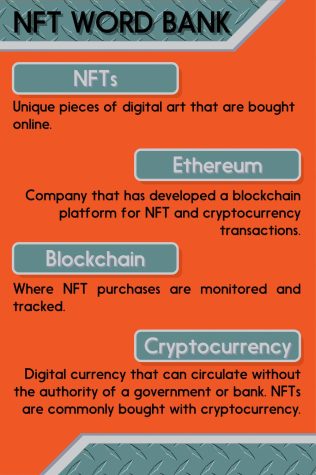The NFT craze
As the digital economy develops, West High students are involved with one of the newest trends: NFTs.
As the world discovers a new facet of the digital economy in NFTs, West High students create their own NFT culture inside the school.
One quick click and a piece of art worth millions is now yours. However, you will never hold it in your hands. This is the reality of Non-Fungible Tokens, or NFTs.
NFTs represent ownership of a piece of digital art, music or video. Purchasing an NFT is like buying an original painting with a certificate of authenticity.
“[They’re] something that you might like, or you might look at, just like all other forms of art,” said Pakshal Jain ’22. “Having some sort of item that signifies, ‘Oh, you’re a fan of this,’ … like another addition to people’s collections or hobbies.”
The “non-fungible” aspect of NFTs means the digital asset is irreplaceable, and there is only one like it. The uniqueness of this digital asset makes it desirable and of value to people involved in the digital economy. Some people question how screenshotting NFTs can affect their purpose and value. However, screenshotting is comparable to owning a picture or print of the Mona Lisa, not the original painting; the originality is what gives NFTs value.

Made in 2014, the first NFT is a pixelated image of an octagon called “Quantum.” Today, this one-of-a-kind art piece is on sale for $7 million.
Since then, trends in media such as video game characters, trading cards, viral social media posts and even memes have pushed the interest in the NFT market. Now, buyers can scroll through digital platforms like OpenSea and Axie Infinity to find and purchase NFTs. Ethereum, a platform that records and verifies exchanges in the digital economy, tracks NFTs as they move through the market.
“[Transactions are] recorded in a ledger in a blockchain, and it can’t be altered. It’s not stored by anybody, which I find fascinating. A blockchain is like a Google spreadsheet that’s recording transactions by users,” said computer science teacher Dominic Audia. “There are breadcrumbs that lead back to people who are using it. Criminals who use it aren’t necessarily safer than using a regular currency. It’s actually public information that authorities can track down.”
The price of an NFT stems from its demand, so it can change over time: as the demand for a digital asset grows, the price of it increases. Biswash Bhattarai ’23, founder of Investing Club at West High, explains how NFTs gain value.
“[An NFT] holds that value that it’s unique, and you can trade that one piece of unique contract on Ethereum with other people for different prices. People think it has value, so it grows in price over time,” Bhattarai said.
Since NFTs can become more valuable, some buyers purchase them intending to invest. Although investing in more risky NFTs comes with the potential of great profit, Rhys Brauns ’22 finds purchasing safer NFTs appealing.
“I just do really safe [investments]. I’m not really traditional, I just know what is safe and what is risky, and I just really like safe betting,” Brauns said. “If the figures behind it are successful, you’ll probably be successful in it. I don’t own anything crazy.”
The potential uses of NFTs continues to develop. After the Ukrainian government scrapped their initial plan to sell NFTs to raise money for the war effort, Ukraine formed a partnership with the creators of a website called Fair.xyz. They plan to sell around 5,000 to 7,000 NFTs that centralize around funding the war. On this platform, the NFTS sold are expected to raise between $2 and $3 million for Ukraine.
“We’re very slowly, but surely, unlocking what [NFTs] can do,” Brauns said.
NFTs also open up new opportunities and security for digital artists.
“NFTs have exploded, and digital artwork artists are being able to have these NFTs and make a decent living by creating some of this,” Audia said. “For years, there was forgery going on in the art world, and this new technology is preventing that and making it so that this is recorded in the ledger, who owns it, and when it was bought.”
However, Audia does not believe NFTs will be sustainable due to the financial toll they might have on artists.
“It’s not easy to make a lot of money selling digital artwork or digital music because there are high fees associated with putting your NFT on [digital platforms],” Audia said. “[Physical] art has always been appreciated in value. Digital art, I’m not sure.”
Jain has noticed a growth of interest surrounding the digital economy at West High.
“[The digital economy] has been a lot more popular, and a lot more people talk more about it,” Jain said. “It’s good because it shows people you don’t always need to be following a certain path to make money.”
He believes that cryptocurrency’s accessibility is what sparked the interest of high schoolers.
“I think that just that sense of being able to make passive income is inviting, and you don’t have to be 18 to get into cryptocurrency,” Jain said. “It’s really easy to get into. It’s an interesting way to make money.”
Bhattarai believes the interest in NFTs is partly due to the integration into popular culture. Shoe companies like Nike and Adidas have started to sell digital sneakers. Additionally, professional sports players now sell digital jerseys and shoes.
“NFTs will be connected to the hype culture, clothing and fashion culture, and to collectibles,” Jain said. “Over time, [NFTs] will be 100 percent integrated like collectibles, and [interest in them] will just keep growing.”
Brauns believes social media has also contributed to the popularity of the digital economy.
“You’ve seen Elon Musk tweet about [the digital economy] and kind of just pump it up. I don’t know how legal that is, but it definitely has a big impact on making it more available and more widespread because most people use social media in some form,” Brauns said.
Jain has observed interest in NFTs growing in other digital communities such as the messaging platform Discord.
“There are a lot of NFT Discords around certain projects, and I think that’s how a lot of these things get popular … people fall into the hype,” Jain said.
After observing the growing culture around the digital economy, Bhattarai started the Investing Club at West. In Investing Club, Bhattarai teaches students about different aspects of the digital economy, including strategies about investing, and starts conversations around upcoming trends, like NFTs. Bhattarai believes that trends like NFTs can create a community in the digital economy.
“I’m trying to bring people together so we all can learn together, all make money, all set ourselves up for the future and invest and grow,” Bhattarai said.
As the culture around NFTs grows, so has environmental concerns surrounding them. For NFTs to be purchased, they have to go through a proof of work process. Proof of work is a mechanism that companies like Ethereum use to validate transactions for NFTs. However, this process requires huge amounts of electricity. Ethereum consumes 73.2 TWh of electricity annually. This amount of energy is the equivalent of energy annually consumed by a medium-sized country like Austria.
“The amount of energy that’s being used [for proof of work] is very concerning. Companies are using vast resources… some countries like China have kicked all the [proof of work platforms] out because of the amount of electricity they’re using,” Audia said.
Despite the potential long-term environmental devastation resulting from NFTs, Jain believes that growth in the interest in NFTs will continue.
“There are still a lot more people who haven’t been exposed to it, who would like to be exposed to it, and I think they’ll keep on growing,” Jain said.
Your donation will support the student journalists of West High School. Your contribution will allow us to purchase Scholarship Yearbooks, newsroom equipment and cover our annual website hosting costs.

(she/her) Krisha Kapoor is a Senior at West High. This is her third year on staff, and she is the Print Co-Editor-In-Chief. Outside of the newsroom, you...

(she/her) Jane Lam is a senior at West High. This is her third year on staff reporting for the print publication. As an assistant copy editor, she loves...




